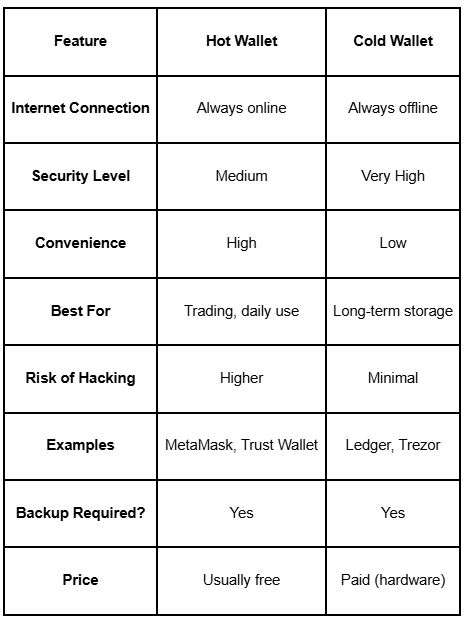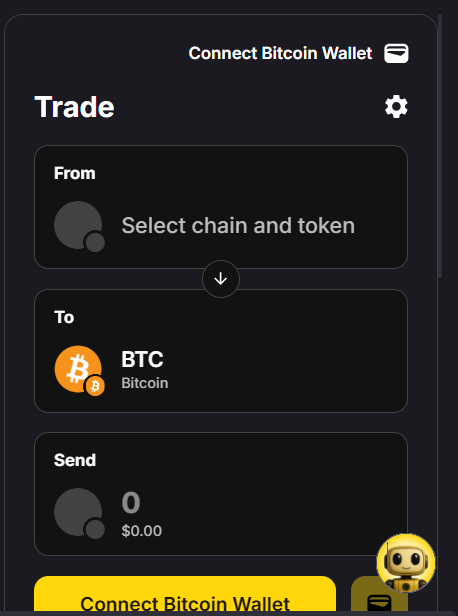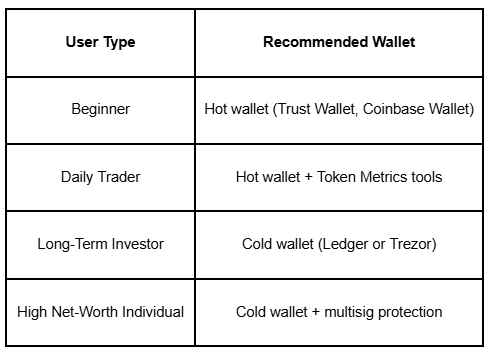Hot Wallets vs. Cold Wallets: What’s the Difference and Which Crypto Wallet To Use in 2025?
.png)
As cryptocurrency adoption accelerates globally in 2025, one critical question for both beginners and experienced investors is: Where should you store your crypto assets safely?
The answer lies in understanding the difference between hot wallets and cold wallets — the two main categories of cryptocurrency storage. This highly informative and SEO-optimized blog will help you understand:
- What hot and cold wallets are
- Key differences between them
- Pros and cons of each
- Which one is right for you
- How platforms like Token Metrics help you choose and manage your wallet securely
🔐 What Is a Cryptocurrency Wallet?
A crypto wallet stores your private and public keys, enabling you to send, receive, and manage digital assets like Bitcoin, Ethereum, or altcoins. Unlike traditional bank accounts, crypto wallets give you full control over your funds — but with that control comes the responsibility of securing them.
Wallets are typically categorized as:
- Hot Wallets – connected to the internet
- Cold Wallets – offline storage solutions
⚡ What Is a Hot Wallet?
A hot wallet is a crypto wallet that is connected to the internet. It’s designed for easy access and quick transactions, making it ideal for active traders and everyday use.
🔹 Examples of Hot Wallets:
- Web wallets: MetaMask, Trust Wallet, Phantom, Rainbow
- Desktop wallets: Exodus, Electrum
- Mobile wallets: Coinbase Wallet, Atomic Wallet
- Exchange wallets: Binance, Coinbase (custodial)
✅ Pros of Hot Wallets:
- Instant access to crypto
- User-friendly interfaces
- Ideal for frequent trading or DeFi
- Compatible with most crypto platforms
❌ Cons of Hot Wallets:
- Vulnerable to hacks and phishing
- Depends on internet connection
- Risk of malware or keylogging
- Not ideal for large holdings
Hot wallets are often recommended for storing smaller amounts of crypto for daily use.
🧊 What Is a Cold Wallet?
A cold wallet refers to any crypto wallet that is not connected to the internet. It’s a form of offline storage designed for maximum security.
🔹 Examples of Cold Wallets:
- Hardware wallets: Ledger Nano X, Trezor Model T
- Paper wallets: Printed QR codes with private keys
- Air-gapped computers: Devices permanently offline
✅ Pros of Cold Wallets:
- Immune to online attacks
- Long-term storage for HODLing
- Control over private keys
- Ideal for institutional and high-net-worth users
❌ Cons of Cold Wallets:
- Less convenient for quick access
- Physical loss or damage is a risk
- Requires technical knowledge
- More expensive (hardware wallets can cost $50–$200)
Cold wallets are ideal for long-term investors storing large amounts of crypto.
🔄 Hot Wallet vs. Cold Wallet: Key Differences

🔧 How to Use Hot and Cold Wallets Together (Hybrid Strategy)
Many crypto investors in 2025 use a dual-wallet strategy:
- Hot wallet for trading, staking, and DeFi
- Cold wallet for long-term storage and high-value assets
This balances convenience and security while minimizing exposure to threats.
For example:
- Use a hot wallet like MetaMask to access the Token Metrics Moonshots tab and buy trending altcoins.
- Transfer profits to your cold wallet (e.g., Ledger) for safekeeping.
🧠 How Token Metrics Helps You Manage Wallet Security
🔹 Wallet Integrations
Token Metrics supports:

- MetaMask, WalletConnect, and other hot wallets
- Portfolio tracking synced with your wallet
- Real-time alerts when assets in your wallet are surging or at risk
🔹 Smart Trading with AI
Token Metrics helps reduce the need to frequently move funds by:

- Identifying only high-quality tokens using AI Trader and Investor Grades
- Sending price alerts, so you know when to buy/sell
- Providing in-platform swap tools for direct trades from your hot wallet
🔹 Moonshot Monitoring
For early-stage altcoins, timing is everything. Token Metrics lets you:

- Monitor your Moonshot investments
- Get notified when to take profits or exit
- Transfer to cold storage with a single click
🔒 Hot Wallet Security Tips (2025 Edition)
If you’re using a hot wallet:
- Enable 2FA (Two-Factor Authentication)
- Use a hardware wallet to sign large transactions
- Avoid clicking suspicious links or connecting to unknown dApps
- Disconnect wallets after use
Always back up your seed phrase and store it securely offline.
💬 Which Wallet Should You Use?

🧩 Final Thoughts
Whether you’re storing $100 or $100,000 in cryptocurrency, your wallet choice directly impacts your security, accessibility, and peace of mind.
- Hot wallets offer convenience, but must be used with caution
- Cold wallets offer security, but come with trade-offs in usability
- Platforms like Token Metrics bridge the gap by offering real-time insights, wallet integrations, and AI-driven trading tools
In 2025, don’t just store your crypto—store it wisely. Combine hot and cold wallet strategies and leverage tools like Token Metrics to build a secure, intelligent crypto portfolio.
Create Your Free Token Metrics Account

.png)




%201.svg)
%201.svg)


%201.svg)



.png)
.png)
%20(1).png)




.svg)




.png)